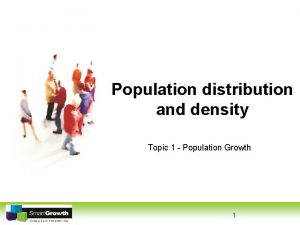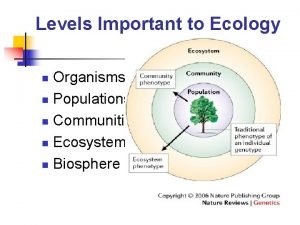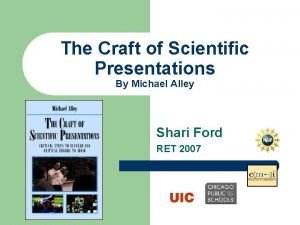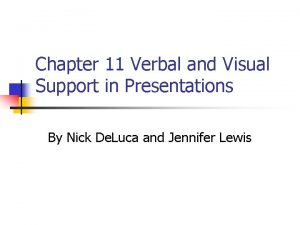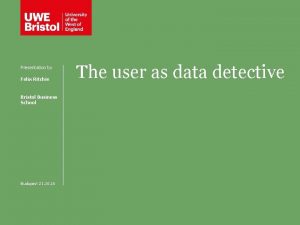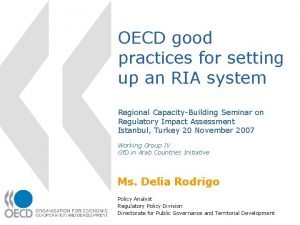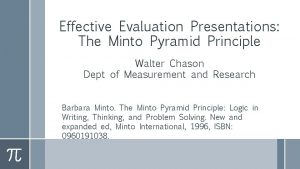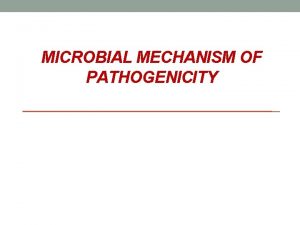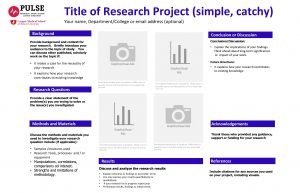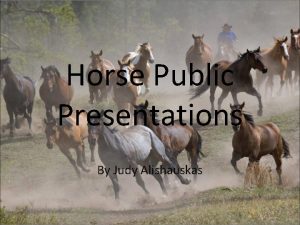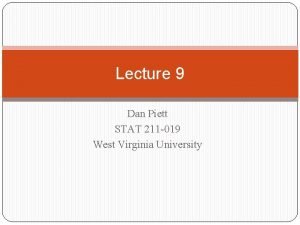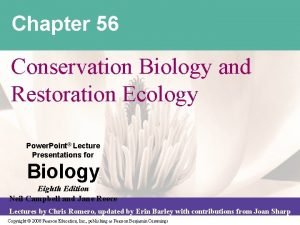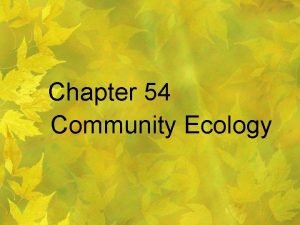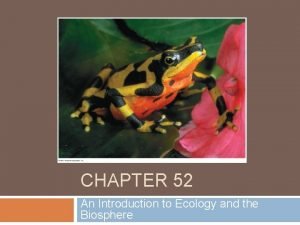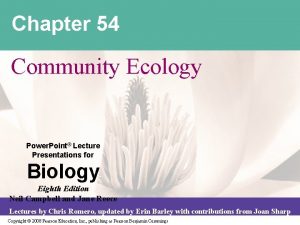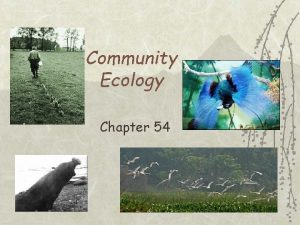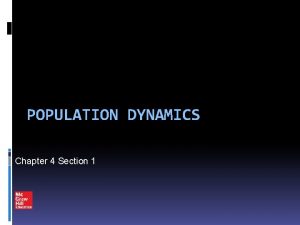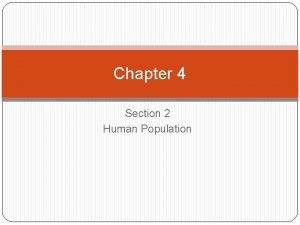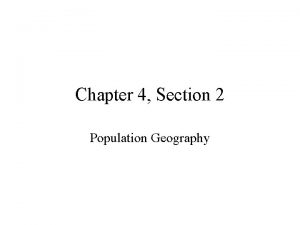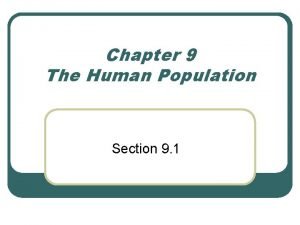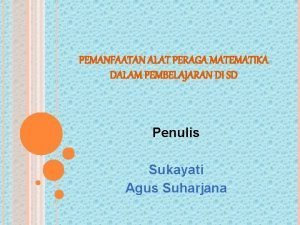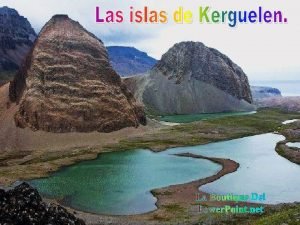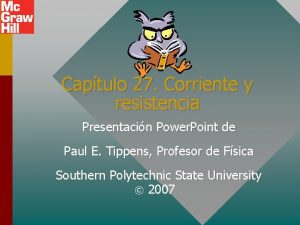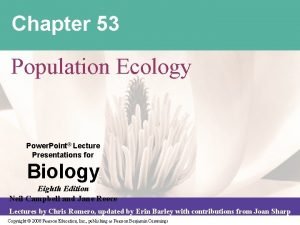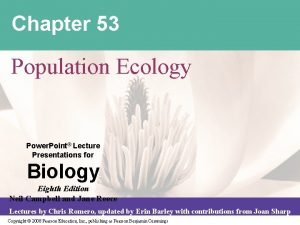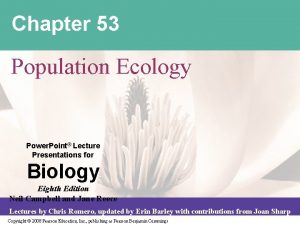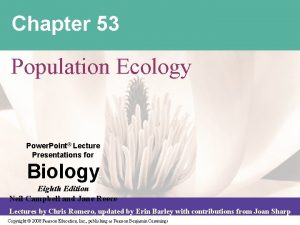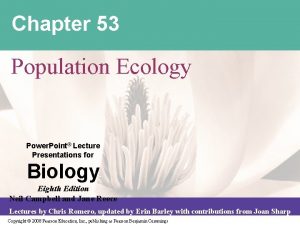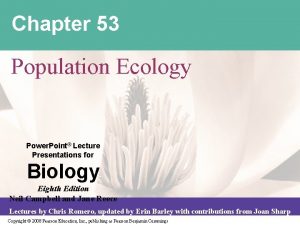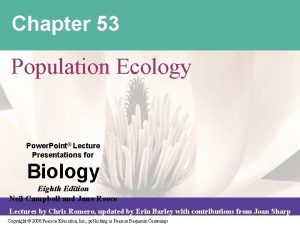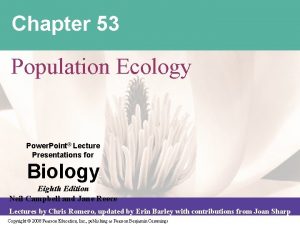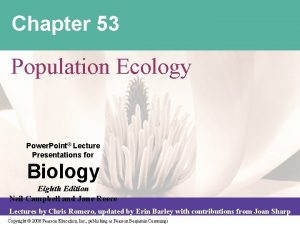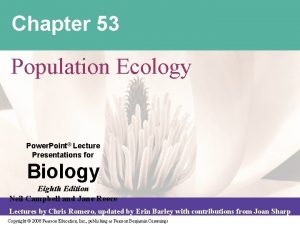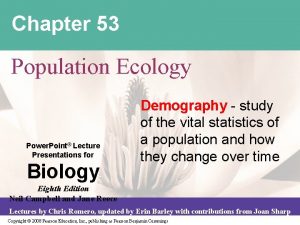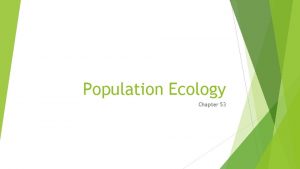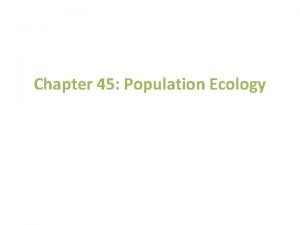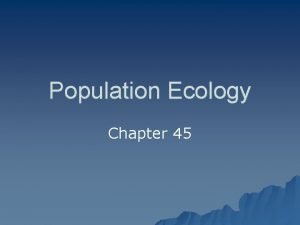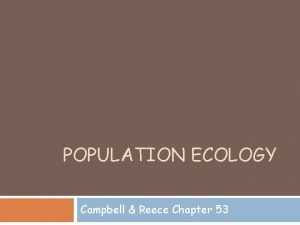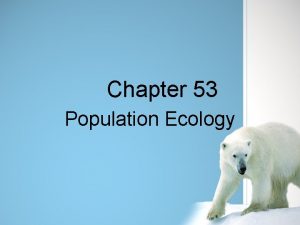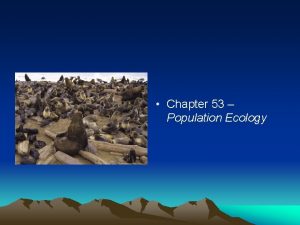Chapter 53 Population Ecology Power Point Lecture Presentations





















































































































- Slides: 117

Chapter 53 Population Ecology Power. Point® Lecture Presentations for Biology Eighth Edition Neil Campbell and Jane Reece Lectures by Chris Romero, updated by Erin Barley with contributions from Joan Sharp Copyright © 2008 Pearson Education, Inc. , publishing as Pearson Benjamin Cummings

Overview: Counting Sheep • A small population of Soay sheep were introduced to Hirta Island in 1932 • They provide an ideal opportunity to study changes in population size on an isolated island with abundant food and no predators Copyright © 2008 Pearson Education, Inc. , publishing as Pearson Benjamin Cummings

Fig. 53 -1

• Population ecology is the study of populations in relation to environment. Copyright © 2008 Pearson Education, Inc. , publishing as Pearson Benjamin Cummings

Concept 53. 1: Dynamic biological processes influence population density, dispersion, and demographics • A population is a group of individuals of a single species living in the same general area Copyright © 2008 Pearson Education, Inc. , publishing as Pearson Benjamin Cummings

Density and Dispersion • Density is the number of individuals per unit area or volume • Dispersion is the pattern of spacing among individuals within the boundaries of the population Copyright © 2008 Pearson Education, Inc. , publishing as Pearson Benjamin Cummings

Density: A Dynamic Perspective • In most cases, it is impractical or impossible to count all individuals in a population • Population size and density can be estimated by sampling, determining an index (tracks, nests, poo), or mark-recapture method Copyright © 2008 Pearson Education, Inc. , publishing as Pearson Benjamin Cummings

Fig. 53 -3 pop growth: d. N/dt=B-D Births and immigration add individuals to a population. Immigration Deaths and emigration remove individuals from a population. Emigration

Fig. 53 -2 APPLICATION Hector’s dolphins

• Density is the result of an interplay between processes that add individuals to a population and those that remove individuals • Immigration is the influx of new individuals from other areas • Emigration is the movement of individuals out of a population Copyright © 2008 Pearson Education, Inc. , publishing as Pearson Benjamin Cummings

Patterns of Dispersion • Environmental and social factors influence spacing of individuals in a population Copyright © 2008 Pearson Education, Inc. , publishing as Pearson Benjamin Cummings

Fig. 53 -4 (a) Clumped (b) Uniform (c) Random

• In a clumped dispersion, individuals aggregate in patches • A clumped dispersion may be influenced by resource availability and behavior (presence of one individual increases probability of more close by) • Exs: starlings, bison Copyright © 2008 Pearson Education, Inc. , publishing as Pearson Benjamin Cummings

Fig. 53 -4 a (a) Clumped

• A uniform dispersion is one in which individuals are evenly distributed • It may be influenced by social interactions such as territoriality (presence of one individual decreases probability of more close by) Video: Albatross Courtship (Uniform) Copyright © 2008 Pearson Education, Inc. , publishing as Pearson Benjamin Cummings

Fig. 53 -4 b (b) Uniform

• In a random dispersion, the position of each individual is independent of other individuals • It occurs in the absence of strong attractions or repulsions. Occurs mostly in plants Video: Prokaryotic Flagella (Salmonella typhimurium) (Random) Copyright © 2008 Pearson Education, Inc. , publishing as Pearson Benjamin Cummings

Fig. 53 -4 c (c) Random

Demographics • Demography is the study of the vital statistics of a population and how they change over time • Death rates and birth rates are of particular interest to demographers Copyright © 2008 Pearson Education, Inc. , publishing as Pearson Benjamin Cummings

Life Tables • A life table is an age-specific summary of the survival pattern of a population • It is best made by following the fate of a cohort, a group of individuals of the same age • The life table of Belding’s ground squirrels reveals many things about this population Copyright © 2008 Pearson Education, Inc. , publishing as Pearson Benjamin Cummings

Table 53 -1

Survivorship Curves • A survivorship curve is a graphic way of representing the data in a life table • The survivorship curve for Belding’s ground squirrels shows a relatively constant death rate Copyright © 2008 Pearson Education, Inc. , publishing as Pearson Benjamin Cummings

Fig. 53 -5 Number of survivors (log scale) 1, 000 100 Females 10 1 Males 0 2 4 6 Age (years) 8 10

• Survivorship curves can be classified into three general types: – Type I: low death rates during early and middle life, then an increase among older age groups – Type II: the death rate is constant over the organism’s life span – Type III: high death rates for the young, then a slower death rate for survivors Copyright © 2008 Pearson Education, Inc. , publishing as Pearson Benjamin Cummings

Number of survivors (log scale) Fig. 53 -6 1, 000 I 100 II 10 III 1 0 50 Percentage of maximum life span 100

Reproductive Rates • For species with sexual reproduction, demographers often concentrate on females in a population • A reproductive table, or fertility schedule, is an age-specific summary of the reproductive rates in a population • It describes reproductive patterns of a population Copyright © 2008 Pearson Education, Inc. , publishing as Pearson Benjamin Cummings

Table 53 -2

Concept 53. 2: Life history traits are products of natural selection • An organism’s life history comprises the traits that affect its schedule of reproduction: – The age at which reproduction begins – How often the organism reproduces – How many offspring are produced during each reproductive cycle Copyright © 2008 Pearson Education, Inc. , publishing as Pearson Benjamin Cummings

Evolution and Life History Diversity • Species that exhibit semelparity, or big-bang reproduction, reproduce once and die. Species live in unpredictable or highly variable environments. LOTS of offspring! • Species that exhibit iteroparity, or repeated reproduction, produce offspring repeatedly. Species live in stable environments. Relatively fewer offspring. Copyright © 2008 Pearson Education, Inc. , publishing as Pearson Benjamin Cummings

Fig. 53 -7

“Trade-offs” and Life Histories • Organisms have finite resources, which may lead to trade-offs between survival and reproduction Copyright © 2008 Pearson Education, Inc. , publishing as Pearson Benjamin Cummings

Fig. 53 -8 Parents surviving the following winter (%) RESULTS 100 Male Female 80 60 40 20 0 Reduced brood size Normal brood size Enlarged brood size

Fig. 53 -9 (a) Dandelion (b) Coconut palm

• Some plants produce a large number of small seeds, ensuring that at least some of them will grow and eventually reproduce Copyright © 2008 Pearson Education, Inc. , publishing as Pearson Benjamin Cummings

Fig. 53 -9 a (a) Dandelion

• Other types of plants produce a moderate number of large seeds that provide a large store of energy that will help seedlings become established Copyright © 2008 Pearson Education, Inc. , publishing as Pearson Benjamin Cummings

Fig. 53 -9 b (b) Coconut palm

• In animals, parental care of smaller broods may facilitate survival of offspring Copyright © 2008 Pearson Education, Inc. , publishing as Pearson Benjamin Cummings

Concept 53. 3: The exponential model describes population growth in an idealized, unlimited environment • It is useful to study population growth in an idealized situation • Idealized situations help us understand the capacity of species to increase and the conditions that may facilitate this growth Copyright © 2008 Pearson Education, Inc. , publishing as Pearson Benjamin Cummings

Per Capita Rate of Increase • If immigration and emigration are ignored, a population’s growth rate (per capita increase) equals birth rate minus death rate Copyright © 2008 Pearson Education, Inc. , publishing as Pearson Benjamin Cummings

• Zero population growth occurs when the birth rate equals the death rate • Most ecologists use differential calculus to express population growth as growth rate at a particular instant in time: N r. N t where N = population size, t = time, and r = per capita rate of increase = birth – death Copyright © 2008 Pearson Education, Inc. , publishing as Pearson Benjamin Cummings

Exponential Growth • Exponential population growth is population increase under idealized conditions-maximum birth rate, all survive to reproduce, no limits to resources. Copyright © 2008 Pearson Education, Inc. , publishing as Pearson Benjamin Cummings

• Equation of exponential population growth: d. N rmax. N dt rmax=rate of increase (maximum) N=population size t=time d=rate The rate of change in a population over time is equal to a constant (rmax) x the population Copyright © 2008 Pearson Education, Inc. , publishing as Pearson Benjamin Cummings

• Exponential population growth results in a Jshaped curve Copyright © 2008 Pearson Education, Inc. , publishing as Pearson Benjamin Cummings

Fig. 53 -10 2, 000 Population size (N) d. N = 1. 0 N dt 1, 500 d. N = 0. 5 N dt 1, 000 500 0 0 5 10 Number of generations 15

• The J-shaped curve of exponential growth characterizes – Rebounding populations – Populations in new environments – Initial growth of populations – Populations with abundant resources and few resistance factors – humans Copyright © 2008 Pearson Education, Inc. , publishing as Pearson Benjamin Cummings

Fig. 53 -11 Elephant population 8, 000 6, 000 4, 000 2, 000 0 1900 1920 1940 Year 1960 1980

Concept 53. 4: The logistic model describes how a population grows more slowly as it nears its carrying capacity • Exponential growth cannot be sustained for long in any population • A more realistic, long-term population model limits growth by incorporating carrying capacity • Carrying Capacity (K) is the maximum population size the environment can support Copyright © 2008 Pearson Education, Inc. , publishing as Pearson Benjamin Cummings

The Logistic Growth Model • In the logistic population growth model, the rate of increase declines as carrying capacity is reached • We construct the logistic model by starting with the exponential model and adding an expression that reduces rate of increase to zero as N approaches K (K N) d. N rmax N dt K Copyright © 2008 Pearson Education, Inc. , publishing as Pearson Benjamin Cummings

• The logistic model of population growth produces a sigmoid (S-shaped) curve Copyright © 2008 Pearson Education, Inc. , publishing as Pearson Benjamin Cummings

Fig. 53 -12 Exponential growth Population size (N) 2, 000 d. N = 1. 0 N dt 1, 500 K = 1, 500 Logistic growth 1, 000 d. N = 1. 0 N dt 1, 500 – N 1, 500 0 0 5 10 Number of generations 15

The Logistic Model and Real Populations • The growth of laboratory populations of paramecia fits an S-shaped curve • These organisms are grown in a constant environment lacking predators and competitors Copyright © 2008 Pearson Education, Inc. , publishing as Pearson Benjamin Cummings

Number of Paramecium/m. L Fig. 53 -13 a 1, 000 800 600 400 200 0 0 5 10 Time (days) 15 (a) A Paramecium population in the lab

• Some populations overshoot K before settling down to a relatively stable density Copyright © 2008 Pearson Education, Inc. , publishing as Pearson Benjamin Cummings

Number of Daphnia/50 m. L Fig. 53 -13 b 180 150 120 90 60 30 0 0 20 40 60 80 100 120 Time (days) 140 What limits populations? 160

• Some populations fluctuate greatly and make it difficult to define K Copyright © 2008 Pearson Education, Inc. , publishing as Pearson Benjamin Cummings

The Logistic Model and Life Histories • Life history traits favored by natural selection may vary with population density and environmental conditions • K-selection, or density-dependent selection, selects for life history traits that are sensitive to population density • r-selection, or density-independent selection, selects for life history traits that maximize reproduction • Which type of selection would best exhibit semelparity? Copyright © 2008 Pearson Education, Inc. , publishing as Pearson Benjamin Cummings

Table 53 -3

• The logistic model fits few real populations but is useful for estimating possible growth Copyright © 2008 Pearson Education, Inc. , publishing as Pearson Benjamin Cummings

Fig. 53 -14

• The concepts of K-selection and r-selection are oversimplifications but have stimulated alternative hypotheses of life history evolution Copyright © 2008 Pearson Education, Inc. , publishing as Pearson Benjamin Cummings

Concept 53. 5: Many factors that regulate population growth are density dependent • There are two general questions about regulation of population growth: – What environmental factors stop a population from growing indefinitely? – Why do some populations show radical fluctuations in size over time, while others remain stable? Copyright © 2008 Pearson Education, Inc. , publishing as Pearson Benjamin Cummings

Population Change and Population Density • In density-independent populations, birth rate and death rate do not change with population density • In density-dependent populations, birth rates fall and death rates rise with population density Copyright © 2008 Pearson Education, Inc. , publishing as Pearson Benjamin Cummings

Fig. 53 -15 Birth or death rate per capita Density-dependent birth rate Densitydependent death rate Equilibrium density Population density (a) Both birth rate and death rate vary. Birth or death rate per capita Densityindependent death rate Densityindependent birth rate Density-dependent death rate Equilibrium density Population density (c) Death rate varies; birth rate is constant. Population density (b) Birth rate varies; death rate is constant.

Density-Dependent Population Regulation • Density-dependent birth and death rates are an example of negative feedback that regulates population growth • They are affected by many factors, such as competition for resources, territoriality, disease, predation, toxic wastes, and intrinsic factors Copyright © 2008 Pearson Education, Inc. , publishing as Pearson Benjamin Cummings

Competition for Resources • In crowded populations, increasing population density intensifies competition for resources and results in a lower birth rate Copyright © 2008 Pearson Education, Inc. , publishing as Pearson Benjamin Cummings

Percentage of juveniles producing lambs Fig. 53 -16 100 80 60 40 200 300 400 500 Population size 600

Territoriality • In many vertebrates and some invertebrates, competition for territory may limit density • Cheetahs are highly territorial, using chemical communication to warn other cheetahs of their boundaries Copyright © 2008 Pearson Education, Inc. , publishing as Pearson Benjamin Cummings

Fig. 53 -17 (a) Cheetah marking its territory (b) Gannets

Fig. 53 -17 a (a) Cheetah marking its territory

• Oceanic birds exhibit territoriality in nesting behavior Copyright © 2008 Pearson Education, Inc. , publishing as Pearson Benjamin Cummings

Fig. 53 -17 b (b) Gannets

Disease • Population density can influence the health and survival of organisms • In dense populations, pathogens can spread more rapidly Copyright © 2008 Pearson Education, Inc. , publishing as Pearson Benjamin Cummings

Predation • As a prey population builds up, predators may feed preferentially on that species Copyright © 2008 Pearson Education, Inc. , publishing as Pearson Benjamin Cummings

Toxic Wastes • Accumulation of toxic wastes can contribute to density-dependent regulation of population size Copyright © 2008 Pearson Education, Inc. , publishing as Pearson Benjamin Cummings

Intrinsic Factors • For some populations, intrinsic (physiological) factors appear to regulate population size Copyright © 2008 Pearson Education, Inc. , publishing as Pearson Benjamin Cummings

Population Dynamics • The study of population dynamics focuses on the complex interactions between biotic and abiotic factors that cause variation in population size Copyright © 2008 Pearson Education, Inc. , publishing as Pearson Benjamin Cummings

Stability and Fluctuation • Long-term population studies have challenged the hypothesis that populations of large mammals are relatively stable over time • Weather can affect population size over time Copyright © 2008 Pearson Education, Inc. , publishing as Pearson Benjamin Cummings

Fig. 53 -18 2, 100 Number of sheep 1, 900 1, 700 1, 500 1, 300 1, 100 900 700 500 0 1955 1965 1975 1985 Year 1995 2005

• Changes in predation pressure can drive population fluctuations Copyright © 2008 Pearson Education, Inc. , publishing as Pearson Benjamin Cummings

Fig. 53 -19 2, 500 50 Moose 40 2, 000 30 1, 500 20 1, 000 10 500 0 1955 1965 1975 1985 Year 1995 0 2005 Number of moose Number of wolves Wolves

Population Cycles: Scientific Inquiry • Some populations undergo regular boom-andbust cycles • Lynx populations follow the 10 year boom-andbust cycle of hare populations • Three hypotheses have been proposed to explain the hare’s 10 -year interval Copyright © 2008 Pearson Education, Inc. , publishing as Pearson Benjamin Cummings

Fig. 53 -20 Snowshoe hare 120 9 Lynx 80 6 40 3 0 0 1850 1875 1900 Year 1925 Number of lynx (thousands) Number of hares (thousands) 160

Fig. 53 -20 a

Fig. 53 -20 b Snowshoe hare 120 9 Lynx 80 6 40 3 0 0 1850 1875 1900 Year 1925 Number of lynx (thousands) Number of hares (thousands) 160

• Hypothesis: The hare’s population cycle follows a cycle of winter food supply • If this hypothesis is correct, then the cycles should stop if the food supply is increased • Additional food was provided experimentally to a hare population, and the whole population increased in size but continued to cycle • No hares appeared to have died of starvation Copyright © 2008 Pearson Education, Inc. , publishing as Pearson Benjamin Cummings

• Hypothesis: The hare’s population cycle is driven by pressure from other predators • In a study conducted by field ecologists, 90% of the hares were killed by predators • These data support this second hypothesis Copyright © 2008 Pearson Education, Inc. , publishing as Pearson Benjamin Cummings

• Hypothesis: The hare’s population cycle is linked to sunspot cycles • Sunspot activity affects light quality, which in turn affects the quality of the hares’ food • There is good correlation between sunspot activity and hare population size Copyright © 2008 Pearson Education, Inc. , publishing as Pearson Benjamin Cummings

• The results of all these experiments suggest that both predation and sunspot activity regulate hare numbers and that food availability plays a less important role Copyright © 2008 Pearson Education, Inc. , publishing as Pearson Benjamin Cummings

Immigration, Emigration, and Metapopulations • Metapopulations are groups of populations linked by immigration and emigration • High levels of immigration combined with higher survival can result in greater stability in populations Copyright © 2008 Pearson Education, Inc. , publishing as Pearson Benjamin Cummings

Fig. 53 -21 ˚ Aland Islands EUROPE 5 km Occupied patch Unoccupied patch

Concept 53. 6: The human population is no longer growing exponentially but is still increasing rapidly • No population can grow indefinitely, and humans are no exception Copyright © 2008 Pearson Education, Inc. , publishing as Pearson Benjamin Cummings

The Global Human Population • The human population increased relatively slowly until about 1650 and then began to grow exponentially Copyright © 2008 Pearson Education, Inc. , publishing as Pearson Benjamin Cummings

Fig. 53 -22 6 5 4 3 2 The Plague 1 0 8000 B. C. E. 4000 3000 2000 1000 B. C. E. 0 1000 C. E. 2000 C. E. Human population (billions) 7

• Though the global population is still growing, the rate of growth began to slow during the 1960 s Copyright © 2008 Pearson Education, Inc. , publishing as Pearson Benjamin Cummings

Fig. 53 -23 2. 2 2. 0 Annual percent increase 1. 8 1. 6 1. 4 2005 1. 2 Projected data 1. 0 0. 8 0. 6 0. 4 0. 2 0 1950 1975 2000 Year 2025 2050

Regional Patterns of Population Change • To maintain population stability, a regional human population can exist in one of two configurations: – Zero population growth = High birth rate – High death rate – Zero population growth = Low birth rate – Low death rate • The demographic transition is the move from the first state toward the second state Copyright © 2008 Pearson Education, Inc. , publishing as Pearson Benjamin Cummings

Birth or death rate per 1, 000 people Fig. 53 -24 50 40 30 20 10 Sweden Birth rate Death rate 0 1750 1800 Mexico Birth rate Death rate 1850 1900 Year 1950 2000 2050

• The demographic transition is associated with an increase in the quality of health care and improved access to education, especially for women • Most of the current global population growth is concentrated in developing countries Copyright © 2008 Pearson Education, Inc. , publishing as Pearson Benjamin Cummings

Age Structure • For humans, one important demographic factor in present and future growth trends is a country’s age structure • Age structure is the relative number of individuals at each age Copyright © 2008 Pearson Education, Inc. , publishing as Pearson Benjamin Cummings

Fig. 53 -25 Rapid growth Afghanistan Male Female 10 8 6 4 2 0 2 4 6 Percent of population Age 85+ 80– 84 75– 79 70– 74 65– 69 60– 64 55– 59 50– 54 45– 49 40– 44 35– 39 30– 34 25– 29 20– 24 15– 19 10– 14 5– 9 0– 4 8 10 8 Slow growth United States Male Female 6 4 2 0 2 4 6 Percent of population Age 85+ 80– 84 75– 79 70– 74 65– 69 60– 64 55– 59 50– 54 45– 49 40– 44 35– 39 30– 34 25– 29 20– 24 15– 19 10– 14 5– 9 0– 4 8 8 No growth Italy Male Female 6 4 2 0 2 4 6 8 Percent of population

• Age structure diagrams can predict a population’s growth trends • They can illuminate social conditions and help us plan for the future Copyright © 2008 Pearson Education, Inc. , publishing as Pearson Benjamin Cummings

Infant Mortality and Life Expectancy • Infant mortality and life expectancy at birth vary greatly among developed and developing countries but do not capture the wide range of the human condition Copyright © 2008 Pearson Education, Inc. , publishing as Pearson Benjamin Cummings

60 80 50 Life expectancy (years) Infant mortality (deaths per 1, 000 births) Fig. 53 -26 40 30 20 60 40 20 10 0 Indus- Less industrialized countries

Global Carrying Capacity • How many humans can the biosphere support? Copyright © 2008 Pearson Education, Inc. , publishing as Pearson Benjamin Cummings

Estimates of Carrying Capacity • The carrying capacity of Earth for humans is uncertain, though the average estimate is 10– 15 billion Copyright © 2008 Pearson Education, Inc. , publishing as Pearson Benjamin Cummings

Limits on Human Population Size • CURRENT WORLD POP: 7, 227, 176, 828 -April 18 th 2013 • The ecological footprint concept summarizes the aggregate land water area needed to sustain the people of a nation • It is one measure of how close we are to the carrying capacity of Earth • Countries vary greatly in footprint size and available ecological capacity Copyright © 2008 Pearson Education, Inc. , publishing as Pearson Benjamin Cummings

• Our carrying capacity is limited by many factors: food, space, nonrenewable resources, and buildup of wastes such as CO 2, garbage, and nuclear waste Copyright © 2008 Pearson Education, Inc. , publishing as Pearson Benjamin Cummings

Fig. 53 -27 Log (g carbon/year) 13. 4 9. 8 5. 8 Not analyzed

Fig. 53 -UN 1 Patterns of dispersion Clumped Uniform Random

Population size (N) Fig. 53 -UN 2 d. N = rmax N dt Number of generations

Population size (N) Fig. 53 -UN 3 K = carrying capacity K–N d. N = rmax N dt K Number of generations

Fig. 53 -UN 4

Fig. 53 -UN 5

You should now be able to: 1. Define and distinguish between the following sets of terms: density and dispersion; clumped dispersion, uniform dispersion, and random dispersion; life table and reproductive table; Type I, Type II, and Type III survivorship curves; semelparity and iteroparity; r-selected populations and K-selected populations 2. Explain how ecologists may estimate the density of a species Copyright © 2008 Pearson Education, Inc. , publishing as Pearson Benjamin Cummings

3. Explain how limited resources and trade-offs may affect life histories 4. Compare the exponential and logistic models of population growth 5. Explain how density-dependent and densityindependent factors may affect population growth 6. Explain how biotic and abiotic factors may work together to control a population’s growth Copyright © 2008 Pearson Education, Inc. , publishing as Pearson Benjamin Cummings

7. Describe the problems associated with estimating Earth’s carrying capacity for the human species 8. Define the demographic transition Copyright © 2008 Pearson Education, Inc. , publishing as Pearson Benjamin Cummings
 Population ecology section 1 population dynamics answer key
Population ecology section 1 population dynamics answer key Chapter 4 section 1 population dynamics
Chapter 4 section 1 population dynamics Population ecology section 1 population dynamics answer key
Population ecology section 1 population dynamics answer key Population ecology section 1 population dynamics
Population ecology section 1 population dynamics Lecture presentations for campbell biology
Lecture presentations for campbell biology Chapter 53 population ecology
Chapter 53 population ecology Equilibrial life history
Equilibrial life history Chapter 4 population ecology answer key
Chapter 4 population ecology answer key Chapter 53 population ecology
Chapter 53 population ecology Chapter 4 population ecology answer key
Chapter 4 population ecology answer key Chapter 53 population ecology
Chapter 53 population ecology Logistic growth ecology definition
Logistic growth ecology definition Define exponential population growth
Define exponential population growth Fig 52
Fig 52 Ecosystem vs community
Ecosystem vs community Concept 3 population ecology
Concept 3 population ecology Population ecology def
Population ecology def Population characteristic
Population characteristic Population characteristics ecology
Population characteristics ecology What is population ecology
What is population ecology Population definition ecology
Population definition ecology Population distribution
Population distribution Parasitism pictures
Parasitism pictures 01:640:244 lecture notes - lecture 15: plat, idah, farad
01:640:244 lecture notes - lecture 15: plat, idah, farad Triangle of power
Triangle of power Power bi power point
Power bi power point Point point power
Point point power Power system dynamics and stability lecture notes
Power system dynamics and stability lecture notes Zline 667-36
Zline 667-36 Power semiconductor devices lecture notes
Power semiconductor devices lecture notes Switch mode power supply lecture notes
Switch mode power supply lecture notes Power system dynamics and stability lecture notes
Power system dynamics and stability lecture notes What are some traditions in things fall apart
What are some traditions in things fall apart The craft of scientific presentations
The craft of scientific presentations Introduction to mental health awareness presentation
Introduction to mental health awareness presentation Worst powerpoint
Worst powerpoint To maintain audience interest in a multimedia presentation
To maintain audience interest in a multimedia presentation Desventajas de corel presentations
Desventajas de corel presentations Developing oral and online presentation
Developing oral and online presentation What is verbal support
What is verbal support Tok presentations
Tok presentations World's worst presentation
World's worst presentation Business presentations bristol
Business presentations bristol Ria seminar presentations
Ria seminar presentations Boardworks ltd
Boardworks ltd Scqa pyramid principle
Scqa pyramid principle Internet presentations
Internet presentations The most dangerous game ppt
The most dangerous game ppt Note cards for presentations
Note cards for presentations The end pictures for presentations
The end pictures for presentations Useful phrases for presentations
Useful phrases for presentations Efficient elements mac
Efficient elements mac You exec slides
You exec slides Research project title
Research project title Catchy titles for presentations
Catchy titles for presentations Cooking merit badge powerpoint
Cooking merit badge powerpoint Customer service presentations
Customer service presentations Cisco stack 3750
Cisco stack 3750 Bad powerpoint presentations examples
Bad powerpoint presentations examples Breaking bad powerpoint template
Breaking bad powerpoint template Yourexec
Yourexec Roof ppt presentations
Roof ppt presentations Https creativemarket.com templates presentations
Https creativemarket.com templates presentations Horse topics for presentations
Horse topics for presentations Types of oral presentations
Types of oral presentations Wvu stat 211
Wvu stat 211 Chapter 52 an introduction to ecology and the biosphere
Chapter 52 an introduction to ecology and the biosphere Study guide chapter 3 section 1 community ecology
Study guide chapter 3 section 1 community ecology Chapter 56 conservation biology and restoration ecology
Chapter 56 conservation biology and restoration ecology Chapter 55 ecosystems and restoration ecology
Chapter 55 ecosystems and restoration ecology Chapter 54: community ecology answer key
Chapter 54: community ecology answer key Chaparral climograph
Chaparral climograph 5 evolution and community ecology
5 evolution and community ecology Principles of ecology chapter 2
Principles of ecology chapter 2 Chapter 2 principles of ecology test answers
Chapter 2 principles of ecology test answers Chapter 2 section 1 organisms and their relationships
Chapter 2 section 1 organisms and their relationships Biological disturbance
Biological disturbance Chapter 55 ecosystems and restoration ecology
Chapter 55 ecosystems and restoration ecology Chapter 5 evolution and community ecology
Chapter 5 evolution and community ecology Chapter 5 evolution and community ecology answer key
Chapter 5 evolution and community ecology answer key Principles of ecology section 2 flow of energy
Principles of ecology section 2 flow of energy Chapter 54 community ecology
Chapter 54 community ecology Management fifteenth edition
Management fifteenth edition Chapter 1 introduction to human resource management
Chapter 1 introduction to human resource management Human resource management lecture chapter 1
Human resource management lecture chapter 1 Chapter 4 section 1 population dynamics
Chapter 4 section 1 population dynamics Chapter 4 section 2 human population
Chapter 4 section 2 human population Chapter 4 section 2 population geography
Chapter 4 section 2 population geography Chapter 2 population and health key issue 3
Chapter 2 population and health key issue 3 Chapter 9 the human population section 1
Chapter 9 the human population section 1 Solar power satellites and microwave power transmission
Solar power satellites and microwave power transmission Actual power and potential power
Actual power and potential power Flex28024a
Flex28024a Formula for dispersive power of grating
Formula for dispersive power of grating Power of a power property
Power of a power property General power rule vs power rule
General power rule vs power rule Power angle curve in power system stability
Power angle curve in power system stability Power absorbed or supplied
Power absorbed or supplied Evangelio del domingo en power point
Evangelio del domingo en power point Aplausos sonido
Aplausos sonido La boutique del power point
La boutique del power point Tennis powerpoint
Tennis powerpoint Tm pp
Tm pp Powerpoint sul riciclo
Powerpoint sul riciclo Fungsi blok dienes
Fungsi blok dienes Sekolah sabat slide show
Sekolah sabat slide show La boutique del powerpoint x
La boutique del powerpoint x La boutique del power point
La boutique del power point La boutique del power point
La boutique del power point La boutique del powerpointx
La boutique del powerpointx Pengertian gizi kuliner
Pengertian gizi kuliner Decreto 1330 del 25 de julio de 2019
Decreto 1330 del 25 de julio de 2019 Powerpoint
Powerpoint Ejemplo de un portafolio
Ejemplo de un portafolio Icon pada toolbar untuk format penomoran adalah…
Icon pada toolbar untuk format penomoran adalah… Formula corriente
Formula corriente Advantages and disadvantages of using powerpoint
Advantages and disadvantages of using powerpoint Ventajas y desventajas de power point
Ventajas y desventajas de power point





















